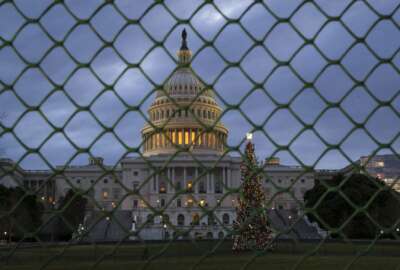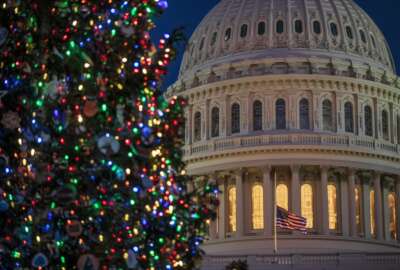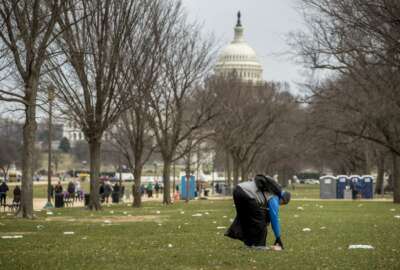
How ‘partial’ is the government shutdown? It depends a lot on the agency
With furlough exceptions focused on protection of life and property, "partial" government shutdown paints a picture of two governments.
Editor’s note: This story has been corrected to reflect the fact that the U.S. Patent and Trademark Office is operating temporarily on funds from prior-year fee collections, and has not yet furloughed employees.
The federal funding impasse that finally came to a head last Friday night has been routinely described over the last several days as only a partial government shutdown, since some agencies are already fully-funded for the year. But among the ones affected, it’s a lot more “partial” in some places than in others.
The closure plans agencies began to execute when their appropriations lapsed at 12:01 on Saturday morning vary widely in their impacts to the public and in the number of federal employees they’ve decided they must furlough with no guarantee of pay. In some, it looks a lot like business as usual. In others, operations have effectively ground to a halt.
At the Homeland Security department, 87 percent of the total workforce has been deemed exempt from furlough, mostly because the majority of employees at agencies like the Border Patrol, Coast Guard, FEMA and TSA are regarded as “necessary for safety of human life or protection of property.”
Even at DHS, though, 32,000 employees have been barred from working, partly because shutdown decisions are based not just on whether a particular employee is “essential.” In general, the workforce that stays on duty during a shutdown is only allowed to perform “excepted activities.”
“Only those functions and activities that are exempt or excepted from the work restrictions specified in the Anti-Deficiency Act (ADA) may continue during a lapse in appropriations,” DHS officials wrote in this month’s updated version of their shutdown guidance, referring to a statute that bars agencies from obligating money without specific appropriations or other legal authorization.
And as many feds learned this week, even long-scheduled training isn’t necessarily an “excepted” activity, regardless of how important it might be to their missions. Consequently, all but 66 of the 1,300 staff at DHS’s Federal Law Enforcement Training Center (FLETC) have been sent home for the duration of the shutdown.
The department’s headquarters offices are mostly-dark too: an estimated 1,584 of the 1,777 employees in its Management Directorate are on emergency furlough.
Commerce furloughs as big a share of workers as DHS exempts
On a department-wide basis, the Department of Commerce is a mirror image of DHS when it comes to the share of the workforce it’s determined it must furlough.
About half of the National Oceanic and Atmospheric Administration (NOAA), which includes the National Weather Service, is still on the job. And the roughly 10,000 temporary workers the Census Bureau has hired so far to handle the 2020 count are exempt, since they’re paid with funds that aren’t implicated in the current budget dispute.
But not counting those temporary staff, Commerce is a ghost of what it was a week ago. Overall, more than 80 percent of the department’s staff were set to be furloughed, according to shutdown contingency plans prepared before appropriations lapse.
A spokesman for the Patent and Trademark Office said the agency is running, for now, on prior-year fee collections. But if the shutdown extends long enough to exhaust those funds, only an estimated 113 people would still be working, compared to a normal staffing level of 12,600.
And a skeleton crew of seven people is running the department’s Office of the Inspector General until the shutdown is over, according to the shutdown guidance .
Not all public-facing services are excepted
Even though administration officials have stressed that they want to make the shutdown as “painless” as possible, they have not always found ways to exempt employees who staff some of the most public-facing government services.
The Interior Department’s shutdown plan, for example, shows that only a small fraction (13 percent) of National Park Service workers have been exempted from furlough.
“Parks must notify visitors that the NPS will cease providing visitor services, including restrooms, trash collection, facilities and roads maintenance (including plowing), campground reservation and check-in/check-out services, backcountry and other permits, and public information,” according to the most recent Park Service contingency plan, published in January. “National and regional offices and support centers will be closed and secured, except where they are needed to support excepted personnel. These steps will be diligently carried out while still ensuring visitor and employee safety as well as the integrity of park resources.”
Elsewhere, the Housing and Urban Development office that handles fair housing and equal opportunity complaints is running on a staff of 5 people per day, compared to its usual 450. And even though NOAA continues to provide weather data via weather.gov, it’s suspended public access to many of its other websites until the shutdown is over.
In the Department of Agriculture, meanwhile, office and bureau staffing levels vary as widely as they do between the various affected cabinet-level departments.
Nearly 90 percent of the Agriculture Marketing Service is still working, as is 69 percent of the Animal and Plant Health Inspection Service. But only 1 percent USDA’s Rural Development office, which manages $220 billion in grants and loans, has been deemed exempt. The shutdown has all but a handfull on furlough at the Economic Research Service.
For some uniformed members, pay dates remain uncertain
Although the shutdown does not impact the Defense Department, tens of thousands of military personnel, who cannot be furloughed, are still affected by the shutdown. Like their excepted civilian colleagues, all of them are expected to show up for work without knowing exactly when they’ll be paid for their efforts.
The uniformed service component of the shutdown includes 41,000 in the Coast Guard, plus members of NOAA’s Commissioned Officer Corps and HHS’s Public Health Service. And whether their next paycheck arrives on time will likely be determined within the next 24-48 hours.
If a shutdown had to happen, the timing at least was somewhat fortuitous for civilian feds, since it coincided exactly with the final day of their previous pay period (Dec. 22). That means their next paychecks — due to be paid on Jan. 4, could arrive on time and in most cases, in their full amounts, if the shutdown ends in time.
But the pay schedule is different for military members. Their next check is due on Dec. 31, and covers the pay period that started on Dec. 16. That period already includes several days in which there have been no available appropriations for DHS and other agencies.
According to the Coast Guard — which also handles payroll for uniformed PHS and NOAA officers — those paychecks are likely to be delayed if the shutdown isn’t resolved before Dec. 28, the day it’s scheduled to finalize its payroll and transmit the data to the Treasury Department.
Copyright © 2025 Federal News Network. All rights reserved. This website is not intended for users located within the European Economic Area.
Jared Serbu is deputy editor of Federal News Network and reports on the Defense Department’s contracting, legislative, workforce and IT issues.
Follow @jserbuWFED
Related Stories





